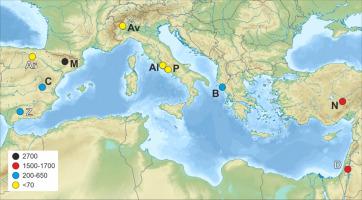Quaternary Science Reviews ( IF 4 ) Pub Date : 2021-08-13 , DOI: 10.1016/j.quascirev.2021.107128 Valentí Rull 1 , Teresa Vegas-Vilarrúbia 2 , Juan Pablo Corella 3 , Mari C. Trapote 2, 4 , Encarni Montoya 5 , Blas Valero-Garcés 6

|
The Pyrenean Lake Montcortès sediments hold the longest continuous and absolutely varve-dated record of the Mediterranean region, encompassing the last three millennia, from the Late Bronze Age to the present. The reconstruction of vegetation and landscape dynamics during this time period has advanced gradually, following the progress of absolute dating by varve counting, and has been progressively published and updated in a number of papers dealing with specific time intervals at different temporal resolutions. This paper synthesizes all these studies in a single composite paleoecological sequence constrained by a single age-depth varve model. The final resolution of this reconstruction is bidecadal, on average, but some periods have been resolved at quasidecadal (Middle Ages) and subdecadal (Modern Age to present) resolutions. The study is focused on the timing of anthropization and the further development of vegetation under climatic and anthropogenic drivers until the shaping of present landscapes. An additional advantage of Montcortès is that the local history of the Pallars region, where the lake is located, is well documented and can be easily correlated with the paleoecological record. Contrary to former interpretations of general landscape anthropization of the Pyrenees during the Middle Ages, the Montcortès catchment was irreversibly transformed by anthropic activities at the beginning of the Iron Age (ca. 750-650 BCE). From this point, the catchment underwent successive transformations due to varied human uses (fire, grazing, cereal cultivation, weed/ruderal plant expansions, hemp cultivation/retting), which have been related to the different cultural phases and sociopolitical changes documented in the local historical records. The regional forests, dominated by Pinus and Quercus, experienced four main clearance events (RD) during the Iron Age (RD1; ca. 300 BCE), the Roman Period (RD2; ca. 300 CE), the Middle Ages (RD3; ca. 1000 CE) and the Modern Age (RD4; ca. 1800 CE). The detailed trends of the last two deforestation events and their causes could be studied at a decadal resolution, which significantly improved interpretation quality in ecological terms. The potential effects of climatic changes and the eventual interactions with human activities on catchment vegetation and regional forests throughout the record have also been discussed. The Montcortès record has been compared with other records at local (Pyrenees), regional (Iberian Peninsula) and biome (Mediterranean) scales. Locally and regionally, anthropization times and further ecological trends showed significant heterogeneity according to elevation, biogeographical patterns and cultural trends. The most significant coincidence is an intensification of human pressure, as noted in forest clearing and extensive land use, during several phases of the Middle Ages. At the Mediterranean level, the Montcortès record emerges as a unique sequence for the western sector of this biome that should be complemented with similar archives from the central and eastern Mediterranean. The most promising candidates for such sequences are discussed on the basis of available Mediterranean varved records.
中文翻译:

独特的比利牛斯山脉斑驳记录详细重建了过去三千年的地中海植被和土地利用动态
比利牛斯山的蒙科尔特斯湖沉积物拥有地中海地区最长的连续和绝对斑纹记录,涵盖了从青铜时代晚期到现在的过去三千年。这一时期植被和景观动态的重建随着变虫计数绝对定年的进展而逐渐推进,并已逐步发表和更新在许多涉及不同时间分辨率的特定时间间隔的论文中。本文将所有这些研究综合在一个单一的复合古生态序列中,该序列受单一年龄深度变量模型的约束。平均而言,这次重建的最终分辨率是 20 年,但某些时期已在 quasidecadal(中世纪)和 subdecadal(现代至今)分辨率下得到解决。该研究的重点是人类化的时间以及在气候和人为驱动因素下植被的进一步发展,直到形成目前的景观。Montcortès 的另一个优势是该湖所在的 Pallars 地区的当地历史有据可查,并且可以很容易地与古生态记录相关联。与中世纪对比利牛斯山脉一般景观人类化的先前解释相反,蒙科尔特斯流域在铁器时代初期(约公元前 750-650 年)被人类活动不可逆转地改变了。从这一点来看,由于人类的不同用途(火、放牧、谷物种植、杂草/粗野植物扩张、大麻种植/沤沤),流域经历了连续的转变,这与当地历史记录中记录的不同文化阶段和社会政治变化有关。区域森林,以松和栎,在铁器时代(RD1;大约公元前 300 年)、罗马时期(RD2;大约公元 300 年)、中世纪(RD3;大约公元 1000 年)和现代( RD4;约公元 1800 年)。最近两次森林砍伐事件的详细趋势及其原因可以在十年分辨率下进行研究,这显着提高了生态方面的解释质量。还讨论了整个记录中气候变化的潜在影响以及与人类活动的最终相互作用对集水植被和区域森林的潜在影响。Montcortès 记录已与当地(比利牛斯)、区域(伊比利亚半岛)和生物群落(地中海)的其他记录进行了比较。在地方和区域上,人类化时间和进一步的生态趋势根据海拔显示出显着的异质性,生物地理模式和文化趋势。最重要的巧合是人类压力的加剧,正如在中世纪的几个阶段森林砍伐和土地广泛利用所指出的那样。在地中海层面,Montcortès 记录是该生物群落西部地区的一个独特序列,应该与地中海中部和东部的类似档案相辅相成。此类序列最有希望的候选者在可用的地中海变种记录的基础上进行了讨论。Montcortès 记录是该生物群落西部地区的一个独特序列,应该与地中海中部和东部的类似档案相辅相成。此类序列最有希望的候选者在可用的地中海变种记录的基础上进行了讨论。Montcortès 记录是该生物群落西部地区的一个独特序列,应该与地中海中部和东部的类似档案相辅相成。此类序列最有希望的候选者在可用的地中海变种记录的基础上进行了讨论。



























 京公网安备 11010802027423号
京公网安备 11010802027423号